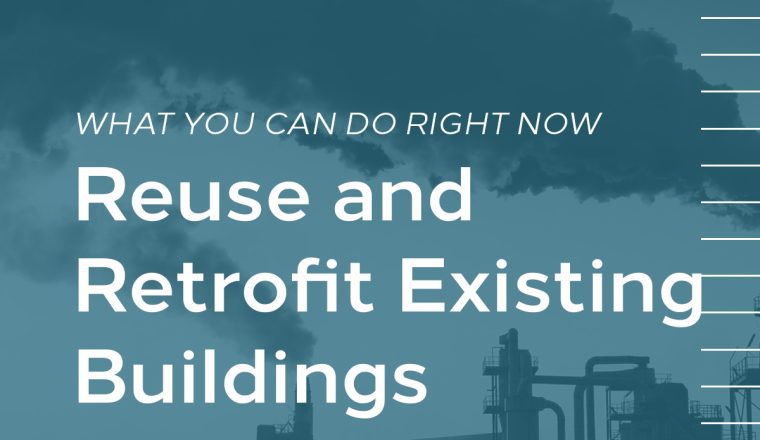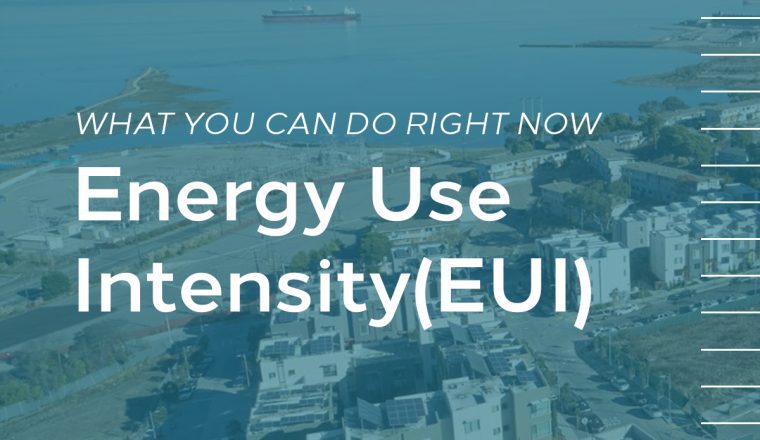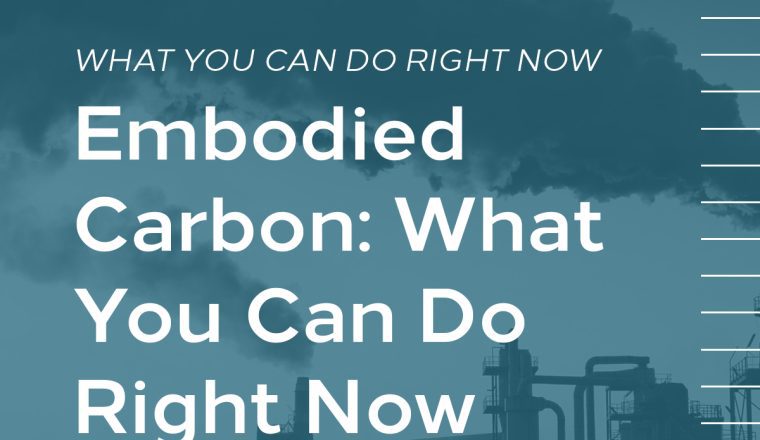What You Can Do Right Now: Reuse and Retrofit Existing Buildings
The built environment is responsible for close to 40% of annual GHG emissions1 — 28% from operating the buildings we already have and 11% from building new ones. To meet global climate action targets for reducing carbon emissions we need to cut both sources of emissions. Architecture 2030 has set achievable targets:
- Operating emissions for new buildings: 80% lower now, carbon neutral by 2030;
- Operating emissions for existing buildings: 50% lower emissions now, carbon neutral by 2050;
- Embodied emissions: 50% lower by 2030, zero by 2050.
Energy codes, building electrification measures, and cleaner grids are moving new buildings towards zero operating emissions, and there is growing focus on reducing the embodied emissions from construction. But these encouraging trends and codes are mostly focused on new buildings. The number of existing buildings is many times higher than the number of new buildings built each year. These existing buildings contain a huge amount of materials (and embodied carbon), they are usually not very efficient, and we can’t afford to replace them all. We cannot ignore them either.
Why Reusing and Upgrading Existing Buildings Matters
Reusing a building – including interior renovations and energy upgrades – has a much lower embodied carbon footprint than new construction – typically 50 to 75% lower, depending on the extent of the renovation. But reuse without improving efficiency is not enough, we also need to reduce current operating emissions by implementing efficiency upgrades, electrification, and cleaner sources of electricity.
Reusing and improving existing buildings also has a societal benefit – it can help rebuild existing neighborhood and financial equity, create local jobs, strengthen community control, and increase neighborhood resilience. Investment in communities that have been subjected to historic discrimination and economic “redlining” has the potential to bring sustainable and equitable climate solutions that also have meaningful economic outcomes to the most impacted communities. To make this potential a reality, decisions must be made by and benefits accrued to those impacted or affected by the improvements.
How are we doing?
Retrofitting, renovating, adapting and remodeling existing buildings accounted for almost half of U.S., architects billing in 2018, an unusually high level for a period of economic growth5 , so we are reusing a lot of our existing buildings. But we are still tearing down perfectly good, functional buildings, with many years of life left in them, and when we do renovate we aren’t reducing operating emissions as much as we need to. We need to double the rate of retrofitting our existing building stock and increase post retrofit performance from 30% to 75%. When we take embodied carbon into account it changes the calculus of when to reuse and retrofit and when to build new. The greatly reduced embodied carbon of reuse shifts the balance towards renovation over building new.
Reusing existing buildings is emerging as a critical strategy in combating climate change. The Greenest Building: Quantifying the Environmental Value of Building Reuse,2 a seminal report published in 2011, introduced this topic, but didn’t significantly alter our approach to existing buildings and carbon emissions. With the increased attention given to embodied carbon, electrification and zero net energy buildings, that is changing. In 2017, a group of preservation architects launched the Zero Net Carbon Collaborative (ZNCC)3. The Climate Heritage Network (CHN)4 – focused on UN heritage sites – was launched at the Global Climate Action Summit in San Francisco a year later. Both organizations are focused on demonstrating, promoting and realizing the carbon benefits of reusing and retrofitting existing buildings.
What can we do?
- Make it easier to reuse buildings: Support AIA California’s petition to amend the California Existing Building Standard to include all IEBC Compliance paths.
- Promote retaining and upgrading existing buildings over new construction – through awards programs, education, communication, and advocacy. Celebrate creative reuse.
- Before deciding to build new, consider reuse + retrofit first. Calculate the carbon emission differential.
- Develop materials for architects, building owners, developers, institutions and planners on the carbon and community benefits of retaining and upgrading existing buildings.
- Advocate for requiring projects that demolish more than 50,000sf to evaluate the carbon impacts/benefits of reuse compared to new construction.
- Advocate for more aggressive goals for energy upgrades and electrification of existing buildings. (U.S. energy efficiency improvement targets are typically 20% – 50%, EU targets are 50% to 80%).
- Advocate for cities to remove barriers to and provide incentives to encourage reuse and retrofit.
- Advocate for building codes to set minimum energy performance levels and minimum technical requirements to address the renovation of existing buildings. Question to address:
- Has the building energy code been revised in light of the renovation targets?
- Is compliance with the building code for renovation and improvement well enforced?
- Do the requirements actively support the uptake of deep renovations in the jurisdiction?
References
- 2019 Global Status Report, Global Alliance for Building and Construction and Architecture (GABC) and Architecture 2030 https://wedocs.unep.org/bitstream/handle/20.500.11822/30950/2019GSR.pdf
- The Greenest Building: Quantifying the Environmental Value of Building Reuse https://forum.savingplaces.org/viewdocument/the-greenest-building-quantifying
- Zero Net Carbon Collaborative https://www.znccollaboration.org
- Climate Heritage Network http://climateheritage.org
- Renovate, retrofit, reuse: Uncovering the hidden value in America’s existing building stock – AIA 2019 http://content.aia.org/sites/default/files/2019-07/RES19_227853_Retrofitting_Existing_Buildings_Report_Guide_V3.pdf
Resources
- Embodied Carbon Benchmarking Study, Carbon Leadership Forum (CLF) – 2017 https://carbonleadershipforum.org/projects/embodied-carbon-benchmark-study/
- Life Cycle Assessment of Tenant Improvement in Commercial Office Buildings & Life Cycle Assessment of Mechanical, Electrical and Plumbing in Commercial Office Buildings, CLF – 2019 https://carbonleadershipforum.org/projects/lca-of-mep-systems-and-tenant-improvements/
- CBECS – Commercial Building Energy Consumption Survey https://www.eia.gov/consumption/commercial/data/2012/
- NEEA Deep Energy Savings in Existing Buildings , New Buildings Institute – https://newbuildings.org/wp-content/uploads/2015/11/NEEA_Meta_Report_Deep_Savings_NBI_Final81520111.pdf
Author: Larry Strain








